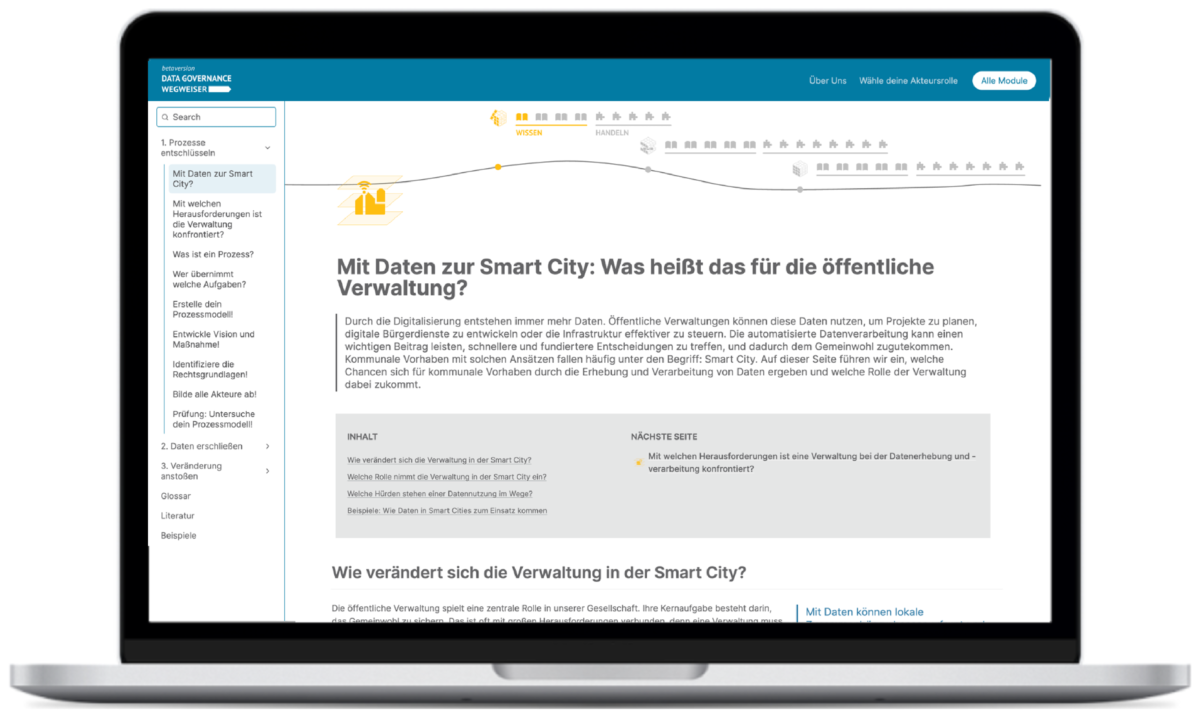Making sense of our connected world

Escaping the digitalisation backlog: data governance puts cities and municipalities in the digital fast lane
German cities and municipalities perform many functions that facilitate our daily lives: They organise traffic, manage schools and childcare centres, and provide social services. Many of these tasks could be improved and simplified by using digital solutions, such as user-friendly transport apps, digital public office services, and data-based traffic planning to reduce congestion. However, for such digital solutions to realise their potential, data from different sources must be meaningfully brought together. In practice, this is often associated with considerable challenges. Projects that use data often fail in the planning phase and become part of the digitalisation backlog. We have investigated the reasons for this and developed a digital handbook based on our research: the Data Governance Guide. This handbook supports German administrations in implementing data-driven projects in a structured and legally compliant manner, ensuring that digital solutions are adopted and provide tangible benefits for citizens.
What is the purpose of data governance?
Imagine if local public transport adapted its timetable according to the number of passengers each day. It could then deploy larger vehicles or increase the frequency of services if demand increased. This would be technically possible, and the necessary data is available in principle. For a project like this to be implemented, however, many parties would need to work together. Transport companies would provide data on routes, vehicles and passenger flows, while the city would provide data on the traffic situation. A technology provider would also need to provide the planning software. This cooperation must be designed so that all laws, particularly those relating to data protection, are complied with. This requires clear regulations: Who is allowed to process which data? How may it be used? How will it be protected, and how long may it be stored for? What requirements must the data meet so that administrations can use it to make decisions?
This is where data governance comes in. It establishes rules for data processing, allocates responsibilities, and organises the process. It also ensures that legal certainty is always guaranteed and that everyone involved ultimately benefits. Digital innovations should not only be technically possible, but should also improve our lives. Although the goal and the rules are often clear, many digital projects are not getting off the ground. They are stuck in a digitalisation backlog. Why is that the case?
Why is implementing digital solutions in cities and municipalities often so difficult?
There are many reasons why digitisation projects grind to a halt. The most important reason is that administrations, companies and citizens interpret the value of data differently depending on the use case. For some, it is an opportunity to do something useful; for others, it poses risks. For data to be used, the benefits must outweigh the risks.
The problem with this is that the risks of data protection or the disclosure of business secrets are often immediately apparent when sharing data with third parties. The benefits, on the other hand, often only become apparent later — for example, when a flexible bus timetable reliably increased passenger numbers. Another problem is that the required data is distributed across many different bodies, including administrations, companies, research institutions, and increasingly, the general public. As benefits and risks assessments change from case to case, and as laws and technology are constantly being adapted, flexible solutions are needed. Many existing data governance concepts are overly complicated and technical, and therefore do not work well in practice.
For successful implementation, the parties involved need to harmonise three areas. Firstly, they must coordinate their processes when working together on a specific project. Secondly, they must ensure that digital solutions function smoothly. Thirdly, they must ensure that legal requirements are complied with. So far, there has been a lack of approaches that allow local employees to implement this independently, not only in individual cases, but also generally and uncomplicatedly in more municipal administrations and communities.
How the Data Governance Guide can help
We developed the Data Governance Guide as part of our “Data & Smart City Governance” project. This digital handbook is aimed directly at administrations, companies, politicians, and citizens. It provides cities and municipalities with practical, three-step instructions for planning and implementing data projects in a comprehensible manner that takes legal requirements into account. The guide was developed with a practical focus and tested in various areas, including air quality management in Berlin and the digital strategy in Haßfurt.
“Measures must be planned according to need. But when is a measure appropriate to the need? This is where the guide comes in. It enables local authorities to track processes and planned measures in a structured manner, record them clearly and highlight processes, actors, data and associated potential at key points.” — Thorsten Kempf, Chief Digital Officer model project Smart Green City Haßfurt
The aim was to investigate how public administrations, companies, and civil society could collaborate to use and process data to help achieve cleaner air. Such projects have enabled us to demonstrate that this approach is not only theoretical, but also practical.

The guide shows how data-driven projects can be better positioned right from the start in three simple steps.
- Understanding processes: First of all, it helps to make processes visible and clarify responsibilities. Our research has shown that administrative processes are often not documented transparently. This results in unclear responsibilities and legal uncertainties when handling data, which slow down many projects at an early stage.
- Exploiting data: The second step is to determine at which points in the process which data can be used. Only then is it checked who has this data, how it can be obtained, and which legal, organisational, or technical issues need to be considered.
- Initiate change: The third step involves engaging stakeholders in a targeted manner to build trust, resolve conflicts early on, and communicate the value to all parties. Many projects come to an early end because it is often difficult to convince administrative employees of the concrete benefits of digital projects, and it becomes even more difficult when external stakeholders such as companies, research institutions or citizens are involved. Although there are formal participation procedures, these often do not provide sufficient opportunity to understand the different expectations regarding the benefits and risks, or to develop joint solutions. Consequently, conflicts usually only become apparent at a late stage and are then difficult to resolve.
The guide provides administrative staff, companies, politicians and citizens with a variety of templates, checklists and concrete examples to successfully navigate these three phases. It provides straightforward answers to legal, organisational and technical questions such as: How does the process work, and who is involved? What data is involved and how is it processed? How can we ensure that everything complies with legal requirements and that the benefits outweigh the risks? Who can get involved in the process and help decide when and how? It turns abstract theory into a practical tool that supports local authorities in implementing their digital ideas.
How data governance can put cities and municipalities on the fast track to the digital age
Digital projects can be successfully implemented if everyone involved works together in a well-coordinated manner and the right structures are in place. Data governance ensures that digitalisation is not hindered by uncertainties and ambiguities, but can instead realise its potential. This means that politicians and administrators receive a better basis for decision-making, citizens save time thanks to digital solutions and have easier access to administrative services. Companies can utilise their digital solutions in cities because they understand the requirements of municipalities when working with data. The Data Governance Guide supports this, showing how diverse interests can be transformed into a shared approach that engages and involves all stakeholders. This makes digital change a tangible development that improves life in cities and municipalities, rather than an abstract vision.
This post represents the view of the author and does not necessarily represent the view of the institute itself. For more information about the topics of these articles and associated research projects, please contact info@hiig.de.

You will receive our latest blog articles once a month in a newsletter.
Data governance
Impactful by design: For digital entrepreneurs driven to create positive societal impact
How impact entrepreneurs can shape digital innovation to build technologies that create meaningful and lasting societal change.
Identifying bias, taking responsibility: Critical perspectives on AI and data quality in higher education
AI is changing higher education. This article explores the risks of bias and why we need a critical approach.
Who spreads disinformation, where, for what purpose, and to what extent?
How much disinformation do German politicians and parties actually spread? On which platforms and to what ends? Two new studies provide systematic answers.




